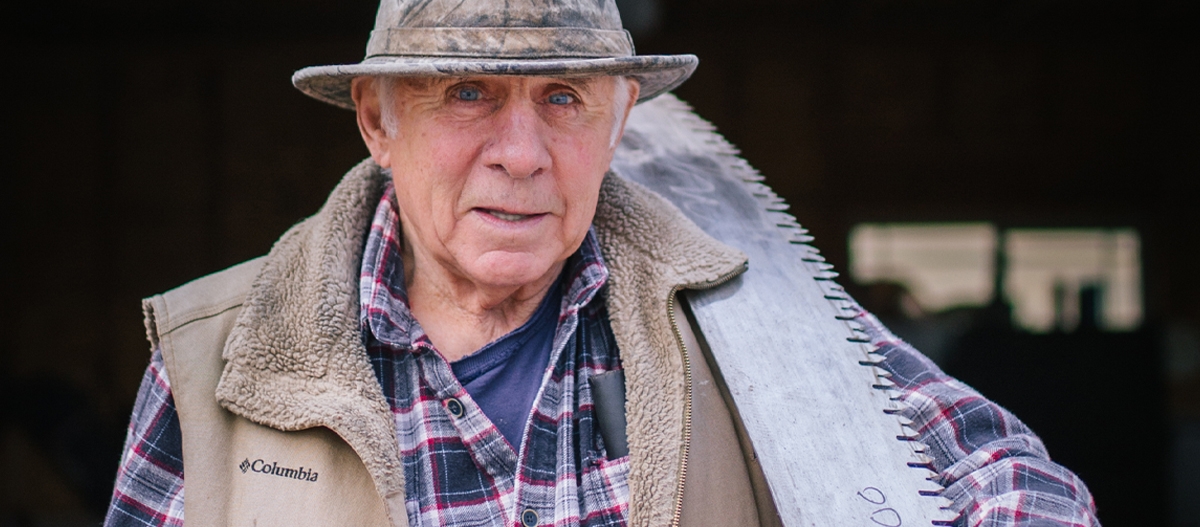By BILL LOMBARDI
You can’t teach an old saw new tricks.
But Helena resident Phil Crist can—he does it all the time.
After decades in the woods and sawmills of Minnesota, Idaho, and Montana, Crist, 81, has invented more than one way to refashion old saws into not only works of art but practical implements used by generations of snowmobilers, four-wheelers, backcountry horsemen and women. Idaho outfitters, Idaho Fish & Game, the U.S. Forest Service, and Montana Conservation Corps even use them to clear trails, cut limbs, and win competitions.
Whom do you call when a tree has fallen across a wilderness trail, and your crosscut blade is dull? Or when you need to win a hand-sawing competition?
Crist, of course.
He is the go-to regional saw builder and sharpener, who cut his teeth under the tutelage of his grandfather and father—barely educated men who taught him the dying art of sawyers, feller bunchers, skidders, blade filers, and the lexicon of crusty old timers who worked the deep woods and perfected the wry sense of humor he employs today.
Ask Crist when he was born, and he says, “Septober nineteen hundred and froze to death.” (He was born in Park Rapids, Minn., southwest of, fittingly, Paul Bunyan State Forest.)
Where do you hunt? “Popcorn forty.”
These retorts, passed down by his father, are meant to confuse the interlocutor and obfuscate the details that might reveal who you are and prepare you to answer those friends who ask you where you shot that bull elk last hunting season.
Crist has collected time-worn sayings and tools that date back more than 100 years, like spider and raker gauges. He uses them to earn what he calls his “beer money,” even though he doesn’t drink beer.
“There are not many people left who know how to sharpen saws,” Crist says. “The old tools are the best. They don’t make nothing that lasts anymore.”
Crist’s garage and workshop contain ancient-looking tools and machines that could have come from the Cast-Iron Age, or before microwaves were invented. They’re used to measure, cut and sharpen blades for the bow, hand, crosscut, hack, pole, pruning, ripcut, band, chain, chop, circular, miter, radial arm, table, and other saws that he refurbishes in his ramshackle shop downhill from the log-frame home he built with his son.
He can repurpose rusty band saw blades (12 inches wide and 40 feet long) from a Townsend, Mont., saw mill, to craft two-handled crosscut saws with 3- to 5-foot blades used for cutting big, rough logs.
Crist came west from Minnesota, through West Yellowstone, Mont., where he cut pulpwood in summer, and then North Fork, Idaho, where he worked in a sawmill and swept floors for the head filer, the tradesperson who maintained and repaired the mill’s saws.
Prior to becoming a professional saw filer—or saw doctor—he had to learn blade physics, geometry, and terminology. He became familiar with terms like tooth spacing, gullet, tooth height, hook angle, tooth set, blade thickness, blade width, pitch, rake, set, and slope.
He worked in the mill’s filing room and was eventually promoted to head filer. His coworkers, who had to work outside, hung a sign over his door: “Phil went to Florida for the winter.” Alongside it hung a license plate from the Sunshine State.
When the North Fork mill shuttered, Crist relocated to work at another in Missoula., where he again became head filer. When that mill closed, he moved to Seeley Lake in western Montana, ending his saw-filing career at the family owned Pyramid Mountain Lumber Inc. He retired in 2002 and now continues working as a freelance saw doctor.
Crist advertises simply—by word of mouth and on his 1993 GMC pickup, which sports cut-out wooden saws lashed to the truck bed’s upright side extender panels with his phone number painted on them. A big old plastic jar with a lid is his bank, into which customers “deposit” fees for his work.
He has the mind of an inventor. He created a fishing spear that has seven steel tines, along with barbs, to pierce wily 30-pound northern pike on Seeley Lake when he’s ice fishing. Another of his creations is a “frost” tooth, used for cutting frozen pine logs.
He also invented a crosscut blade to use on dry wood. Crosscut blades typically have two sets of teeth, the short rakers and the cutting teeth. This particular blade has no raker teeth, because they are not necessary for removing the woodshavings produced in wetter, green logs.
Customers, including those who use hand saws for work in backcountry wilderness where chainsaws are prohibited, like his work.
Crist saves letters of appreciation, like the note from a woman who lives near Unionville, Mont., and whose return address included the line, “future world champion cross cutter.”
“Wow, I am speechless,” Anna Baker, a professional carpenter, wrote to him after she received one of his crosscut saws as a gift from Crist and a friend. “Your gift is so unexpected, so generous, and so incredibly beautiful! I am honored! Thank you for believing in me. I am thrilled to have the pleasure of sawing with your handmade saw and can’t wait to compete again!”
Baker today admits that she has tempered her dreams of becoming a champion crosscutter. She instead uses her collection of Crist-sharpened saws to cut firewood for her family and competes at the Red Ants Pants Music Festival’s crosscut competition near White Sulphur Springs, Mont., in summer.
She likes the physicality of sawing and seeing the results—firewood.
Baker wonders why someone would join a gym to exercise “when they could come to my gym and see something for their efforts.”
Crist, meanwhile, fondly remembers competing in lumberjack contests in Idaho—Salmon, North Fork, Crouch, Orofino—and Darby, Mont.
“I won quite a few times,” he recalls about the chopping, sawing, and climbing contests. “Mine [saw blades] were sharper than the others. Then a guy got older, and the kids got younger. And I quit going.”
He recalls, though, cutting a 22-inch diameter log in 11 seconds with a two-person crosscut saw. Those were the good old days, when he guided elk hunts in the mountains near Salmon and maintained 41 horses.
“I liked to get the hell out of there and lay on top of a mountain in my sleeping bag, looking up at blue skies,” he says. “It was bad when an airplane flew over.”
Crist could have been dreaming then that an old saw really does have nine lives. ISI









